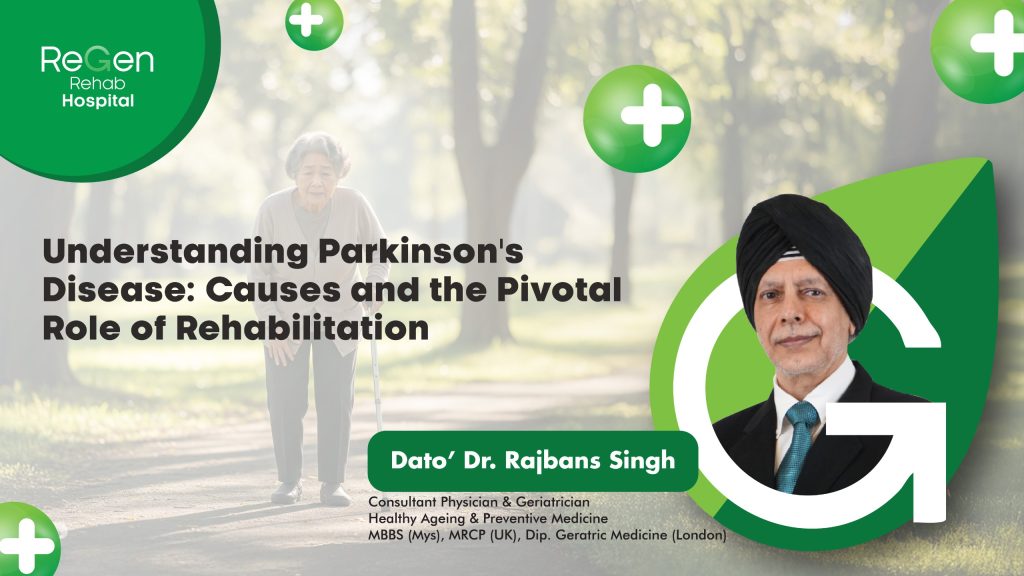Parkinson’s Disease (PD) is a complex and progressive neurodegenerative disorder that impacts millions worldwide. Characterised primarily by motor symptoms like tremors, rigidity, and slowness of movement, PD also presents a range of non-motor challenges, significantly affecting an individual’s quality of life.
While a cure remains elusive, a deep understanding of its causes and the crucial role of rehabilitation can empower individuals to manage the condition effectively and maintain independence.
Unravelling the Causes of Parkinson’s Disease
At its core, Parkinson’s Disease is fundamentally linked to the loss of specific nerve cells in a region of the brain called the substantia nigra. These vital neurons are responsible for producing dopamine, a chemical messenger essential for smooth and coordinated body movements. As these dopamine-producing cells degenerate, dopamine levels in the brain decrease, leading to the hallmark motor symptoms of PD.
Symptoms typically begin to manifest when approximately 50% or more of these cells have been lost.
While the precise reason for this neuronal degeneration is still not fully understood, current research suggests that Parkinson’s arises from a complex interplay of genetic predispositions and environmental factors.
Genetic Factors: While most cases of Parkinson’s are considered “idiopathic” (meaning the cause is unknown), a small percentage (around 10-20%) are linked to specific genetic mutations. These genetic variations can increase an individual’s susceptibility to the disease.
Although it’s rare for PD to be directly inherited, having a close family member with Parkinson’s can slightly elevate one’s risk. Ongoing research continues to identify new genes and understand their role in the disease’s development.
Environmental Factors: Exposure to certain environmental toxins and chemicals has been implicated in an increased risk of Parkinson’s. For instance, long-term exposure to pesticides and herbicides, commonly found in agricultural settings, has been investigated as a potential contributing factor.
Similarly, repeated head trauma, such as that experienced by boxers, has also been linked to an elevated risk. However, it’s important to note that no single environmental factor has been definitively proven as a direct cause, and most people exposed to these factors do not develop Parkinson’s.
Other Contributing Factors:
Lewy Bodies and Alpha-Synuclein: A significant pathological hallmark of Parkinson’s disease is the presence of Lewy bodies – abnormal clumps of protein found within the brain cells of individuals with PD. A key component of these Lewy bodies is a misfolded protein called alpha-synuclein. Researchers believe that the accumulation of this dysfunctional protein plays a critical role in the degeneration of dopamine-producing neurons.
Age: Age is the most significant risk factor for Parkinson’s disease. While early-onset Parkinson’s can occur, the average age of onset is around 60, with the risk increasing considerably after the age of 50.
Male Sex: Statistically, men are more likely to develop Parkinson’s disease than women, although the reasons for this disparity are not yet clear.
The Indispensable Role of Parkinson’s Rehabilitation
Given that there is currently no cure for Parkinson’s Disease, rehabilitation emerges as a cornerstone of management, playing an indispensable role in improving symptoms, enhancing functional abilities, and maintaining a high quality of life.
Far from being a last resort in the later stages of the disease, rehabilitation should be an integral part of care from the point of diagnosis and throughout the disease progression.
Why is Rehabilitation So Important?
- Symptom Management: Parkinson’s symptoms, both motor (tremors, stiffness, bradykinesia, balance problems) and non-motor (fatigue, depression, cognitive changes, speech and swallowing difficulties), can be profoundly disruptive. Rehabilitation therapies are specifically designed to mitigate these symptoms, helping individuals regain control over their movements and manage other challenges.
- Maintaining and Improving Function: The progressive nature of PD often leads to a decline in functional independence. Rehabilitation aims to counteract this by helping individuals maintain and even improve their ability to perform daily living activities (ADLs), such as dressing, eating, bathing, and walking. This sustained independence significantly impacts an individual’s self-esteem and overall well-being.
- Enhancing Mobility and Preventing Falls: Balance impairments and gait difficulties are common in PD, significantly increasing the risk of falls. Physical therapy, a core component of rehabilitation, focuses on improving balance, gait, flexibility, and strength through targeted exercises. Techniques like amplitude training (e.g., LSVT BIG therapy) encourage larger, more exaggerated movements to counteract the small, shuffling steps often seen in PD. Balance training and specific gait exercises can reduce fall risk and boost confidence in mobility.
- Addressing Non-Motor Symptoms: Rehabilitation extends beyond physical challenges. Speech therapy helps individuals manage voice changes (dysphonia) and swallowing difficulties (dysphagia), which are prevalent in PD. Occupational therapy provides strategies and adaptations to make daily tasks easier and safer, preserving independence in activities like meal preparation and personal care. Psychological support and neuropsychology can address cognitive changes, depression, and anxiety, which are often co-occurring.
- Promoting Neuroplasticity: Emerging evidence suggests that intense, goal-directed exercise, as part of rehabilitation, can promote neuroplasticity—the brain’s ability to reorganise itself by forming new neural connections. This means that engaging in regular and appropriate rehabilitation exercises might not only manage symptoms but also potentially slow down the disease progression.
- Empowerment and Education: Rehabilitation programs educate individuals with Parkinson’s and their caregivers about the disease, medication management, coping strategies, and techniques to manage symptoms effectively. This knowledge empowers individuals to take an active role in their care and make informed decisions.
- Multidisciplinary Approach: Effective Parkinson’s rehabilitation typically involves a multidisciplinary team, including neurologists, physical therapists, occupational therapists, speech-language pathologists, dietitians, and psychologists. This collaborative approach ensures that all aspects of the disease are addressed comprehensively and that interventions are tailored to the individual’s evolving needs.
The Call for Early Intervention
Despite the clear benefits, rehabilitation care for Parkinson’s is often underutilised. A significant misconception is that it should only commence in the later stages of the disease. However, research and expert consensus strongly advocate for early intervention. Starting rehabilitative care at diagnosis can proactively limit or prevent functional decline, allowing individuals to maintain their abilities and independence for longer. Regular assessments and adaptations to rehabilitation plans are crucial as the disease progresses.
In conclusion, while the search for a cure for Parkinson’s Disease continues, understanding its complex causes and embracing the transformative power of rehabilitation are paramount. Rehabilitation is not merely supportive care; it is an active and essential intervention that significantly improves the quality of life for individuals living with Parkinson’s, enabling them to navigate the challenges of the disease with greater independence and dignity.

